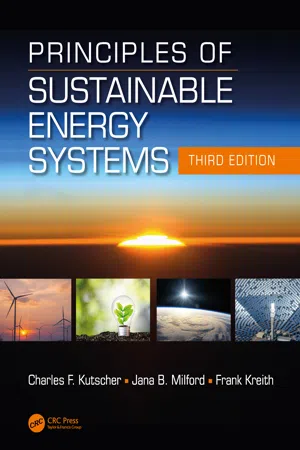
eBook - ePub
Available until 16 Mar |Learn more
Principles of Sustainable Energy Systems, Third Edition
This book is available to read until 16th March, 2026
- 630 pages
- English
- ePUB (mobile friendly)
- Available on iOS & Android
eBook - ePub
Available until 16 Mar |Learn more
Principles of Sustainable Energy Systems, Third Edition
About this book
PRINCIPLES OF SUSTAINABLE ENERGY SYSTEMS, Third Edition, surveys the range of sustainable energy sources and the tools that engineers, scientists, managers, and policy makers use to analyze energy generation, usage, and future trends. The text provides complete and up-to-date coverage of all renewable technologies, including solar and wind power, biofuels, hydroelectric, nuclear, ocean power, and geothermal energy. The economics of energy are introduced, with the SAM software package integrated so students can explore the dynamics of energy usage and prediction. Climate and environmental factors in energy use are integrated to give a complete picture of sustainable energy analysis and planning.
Frequently asked questions
Yes, you can cancel anytime from the Subscription tab in your account settings on the Perlego website. Your subscription will stay active until the end of your current billing period. Learn how to cancel your subscription.
No, books cannot be downloaded as external files, such as PDFs, for use outside of Perlego. However, you can download books within the Perlego app for offline reading on mobile or tablet. Learn more here.
Perlego offers two plans: Essential and Complete
- Essential is ideal for learners and professionals who enjoy exploring a wide range of subjects. Access the Essential Library with 800,000+ trusted titles and best-sellers across business, personal growth, and the humanities. Includes unlimited reading time and Standard Read Aloud voice.
- Complete: Perfect for advanced learners and researchers needing full, unrestricted access. Unlock 1.4M+ books across hundreds of subjects, including academic and specialized titles. The Complete Plan also includes advanced features like Premium Read Aloud and Research Assistant.
We are an online textbook subscription service, where you can get access to an entire online library for less than the price of a single book per month. With over 1 million books across 1000+ topics, we’ve got you covered! Learn more here.
Look out for the read-aloud symbol on your next book to see if you can listen to it. The read-aloud tool reads text aloud for you, highlighting the text as it is being read. You can pause it, speed it up and slow it down. Learn more here.
Yes! You can use the Perlego app on both iOS or Android devices to read anytime, anywhere — even offline. Perfect for commutes or when you’re on the go.
Please note we cannot support devices running on iOS 13 and Android 7 or earlier. Learn more about using the app.
Please note we cannot support devices running on iOS 13 and Android 7 or earlier. Learn more about using the app.
Yes, you can access Principles of Sustainable Energy Systems, Third Edition by Charles F. Kutscher,Jana B. Milford,Frank Kreith in PDF and/or ePUB format, as well as other popular books in Physical Sciences & Thermodynamics. We have over one million books available in our catalogue for you to explore.
Information
1
Introduction to Sustainable Energy
It is evident that the fortunes of the world’s human population, for better or for worse, are inextricably interrelated with the use that is made of energy resources.
M. King Hubbert (1969)
The development of human society and our quality of life are inextricably linked to our use of energy. The emergence of coal in the eighteenth century made possible the Industrial Revolution, and widespread electrification in the twentieth century brought with it all manner of labor-saving devices from washing machines to clothes driers to refrigerators. Similarly, the advent of internal combustion engine vehicles in the early 1900s, followed by the airplane, turned us into a highly mobile society. All of this was made possible by fossil fuels. But after a century of growth and technological advances powered by these fuels, we have come to realize that we humans had made a large-scale Faustian bargain.
In exchange for the wonders of these fossil fuels, we are now coming to grips with their serious side effects. Air pollution from the burning of coal and oil has led to a wide range of health problems from childhood asthma to other life-threatening lung diseases. Acid rain has contaminated lakes, and mercury emissions have poisoned fish and so compromised our food supply. And, most importantly, as we have learned over the last several decades, the carbon dioxide (CO2) emissions emanating from power plant smokestacks and vehicle tailpipes are increasing the infrared radiation-absorbing blanket in our atmosphere, which is heating the Earth and causing it to rapidly depart from the 10,000-year period of steady temperature that allowed human civilization to develop. We are already seeing the effects of global warming, which includes the melting of ice sheets (see Figure 1.1), rising sea level, and an increase in extreme weather events.

Figure 1.1
People in front of a melting glacier, Kangerlussuaq, Greenland.
Although measures have been taken to reduce air pollution by cleaning up stack emissions from power plants and capturing tailpipe emissions from cars, these have only been temporary solutions to an energy system that has a fundamental flaw. The burning of fossil fuels is not sustainable. Fossil fuels are the result of millions of years of nature sequestering atmospheric CO2 in the ground, and we are releasing all that carbon in a timescale of decades. Although it is technically feasible to capture the carbon in fossil fuels and sequester it in the ground again, the fundamental solution to these issues is to convert our unsustainable, carbon-emitting energy sources to sustainable, carbon-free ones. To accomplish that transition, we need to simultaneously reduce our energy needs by using energy much more efficiently and produce the energy from noncarbon sources. This book introduces the knowledge and tools energy professionals and informed citizens will need to lead this twenty-first-century energy transition.
The purpose of this chapter is to give an overview of the principles of sustainability in the context of energy engineering. Section 1.1 gives a historical review of sustainability principles. Section 1.2 presents the critical issues for sustainability: population, water, food and growth, and the relationships between these systems and energy use. Section 1.3 presents some context for the complex nature of sustainable energy by looking at the world energy system of the past, present, and future and the urgent challenge of addressing climate change. Section 1.4 explains some of the most important considerations you must understand to effectively deal with sustainability in engineering, including energy return on energy invested (EROI) and the costs of energy. Section 1.5 explains the most cost-effective of all sustainable energy strategies—reducing energy demand by improving efficiency. Section 1.6 gives an overview of conventional fossil and nuclear energy. Section 1.7 reviews the technology, history, current status, and future prospects for renewable resources including geothermal, hydro, wind, solar, biomass, and the ocean. Section 1.8 discusses the issues involved in the concept of a hydrogen economy.
A unique feature of this book is that it makes use of energy design tools developed by the National Renewable Energy Laboratory (NREL). In particular, this book includes numerous detailed examples of the design of renewable energy systems using the freely available System Advisor Model (SAM). An introduction to SAM is presented in Section 1.9, whereas NREL building energy modeling tools are utilized in Chapter 4, “Energy Use and Efficiency in Buildings and Industry.”
1.1Sustainability Principles
This book focuses mostly on the engineering challenges confronting our efforts to achieve sustainability, but it is important to keep in mind that the development of energy sustainability is taking place in an era when other relevant forces impinge on one another. The energy challenge also involves societal issues such as population growth, resource depletion, and environmental degradation. As shown in Figure 1.2, all of these issues impinge upon the engineering design and economics of a sustainable energy future.

Figure 1.2
The interrelated nature of engineering, social, and environmental issues. (From Alliance for Water Efficiency and American Council for an Energy-Efficient Economy, May 2011. Addressing the energy-water nexus: A blueprint for action and policy agenda; ASME, ETP. Energy–water nexus—Cross-cutting impacts. [1])
Although this book does not directly cover these other issues, it is important to keep them in mind because, unless the political and social systems support the road map toward a sustainable energy future, social obstacles can impede the implementation of long-term solutions that are technically reasonable as well as economically acceptable. For the reader interested in these social issues, several books in the supplemental reading list at the end of the chapter will provide further background information.
The energy choices made today are among the most important of any choices in human history. Although energy development questions may appear to be mostly technical and economic, there are broader considerations. S...
Table of contents
- Cover
- Half Title
- Title Page
- Copyright Page
- Dedication
- Contents
- Foreword
- Preface
- Acknowledgments
- Authors
- Contributors
- 1. Introduction to Sustainable Energy
- 2. Economics of Energy Generation and Conservation Systems
- 3. Energy Systems Analysis Methodologies
- 4. Energy Use and Efficiency in Buildings and Industry
- 5. Electricity Supply Systems
- 6. Fossil Fuels
- 7. Nuclear Energy
- 8. Wind Energy
- 9. Capturing Solar Energy through Biomass
- 10. Fundamentals of Solar Radiation
- 11. Photovoltaics
- 12. Solar Thermal Collectors and Systems
- 13. Ocean, Hydropower, and Geothermal Energy Conversion
- 14. Storage Technologies
- 15. Transportation
- Index